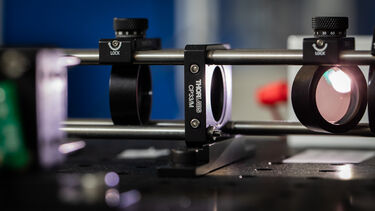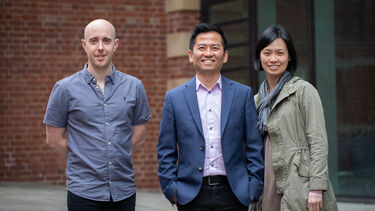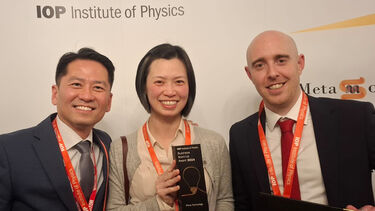The invisible power of infrared sensor technology
From self-driving cars to facial recognition, infrared sensors are all around us and our novel semiconductor research is taking this technology to the next level. Phlux - a ║¨┬½Ë░ÊÁ spinout -has developed high-performance infrared sensors that are set to drive advancements in industries worldwide.

Millions of infrared sensors are sold each year for communications and sensing systems, and they quietly power many of the technologies that underpin modern society. Even though we canÔÇÖt see the radiation they detect, the devices are responsible for medical breakthroughs, environmental monitoring, safer mobility, robotics, and even the face ID on smartphones.
These sensors ÔÇÿseeÔÇÖ heat by detecting infrared photons, which are tiny particles of heat radiation. When these photons hit a semiconductor component called a photodiode, they convert the infrared light into an electrical signal. This signal allows the sensors to detect and measure the presence of an object from its surrounding environment, even those invisible to the human eye.
At the University of ║¨┬½Ë░ÊÁ, weÔÇÖre a global leader in semiconductor research, with the School of Electrical and Electronic Engineering hosting the - a key part of the UKÔÇÖs semiconductor R&D. This research has played a pivotal role in producing world-class semiconductors that have not only driven the internet age but powered high-speed connectivity across the globe.
Despite these breakthroughs and a surge in demand for more sophisticated infrared sensor systems, performance improvements have slowed in recent years. This is largely due to the limitations of conventional silicon and InP-based semiconductor materials, which have hindered their integrations with new technologies.
However, our internationally-leading photonics researchers at ║¨┬½Ë░ÊÁ have introduced, and continue to explore, alternative semiconductor materials that are accelerating the capabilities of current sensor technology.
║¨┬½Ë░ÊÁÔÇÖs world-class novel semiconductor research
Chee Hing Tan, Professor of Opto-Electronic Sensors at the University of ║¨┬½Ë░ÊÁ, has pioneered a number of novel semiconductor materials for infrared detection; gaining a world-leading reputation in detector research. For the last two decades, Professor Chee Hing Tan has studied alternatives to silicon-based infrared sensors, with the aim of improving their sensitivity, resolution, and speed.
ÔÇ£In terms of the infrared space that I work in, especially InP based infrared avalanche photodiodes (APDs), there hasn't been much progress in the last 50 years. The technology has reached a saturation point and has been stuck there with very minor improvementsÔÇØ explains Professor Tan.
Led by Professor Tan, a team of ║¨┬½Ë░ÊÁ researchers identified Antimony, a brittle, silvery-white metal found in the EarthÔÇÖs crust, as a material capable of revolutionising the Light Detection and Ranging (LiDAR) sensor market. Antimony provides a number of key advantages over traditional silicon-based APDs for LiDAR sensors by operating in the 'eye-safe' 1550 nm infrared range. This is essential for industries and environments where people may be present, such as in self-driving cars.
Silicon-based APDs cannot detect light at this longer wavelength, and are designed to operate in the visible and near-infrared range below 1000 nm, which also limits the optical power used at the transmitter to ensure eye-safe operation. LIDAR systems operating at 1550 nm, however, can transmit over 1,000 times more photons compared to those using silicon counterparts, enabling antimony-based sensors to achieve greater range, higher pixel density, and affordability for mass-market applications.
Recognising the commercial potential of their research, Professor Chee Hing Tan, Dr Ben White and Professor Jo Shien Ng founded the ║¨┬½Ë░ÊÁ spinout company, , in 2020 to bring this innovation to market.
Phlux Technology
Phlux Technology is a spinout from the University of ║¨┬½Ë░ÊÁ developing and commercialising breakthrough infrared sensors. The APDs are the worldÔÇÖs first antimony-based LiDAR sensor chips with architecture that are 12 times more sensitive and have 50 percent more range compared to current silicon-based sensors. The design also reduces the cost of manufacture of LiDAR sensors, making them more affordable and accessible to consumers.
In 2022, the company secured ┬ú4 million in seed funding in a round led by Octopus Ventures, with other investors including and Foresight Group. The team also received backing from the UniversityÔÇÖs Intellectual Property Development and Commercialisation (IPDaC) fund. This investment helped the founders launch a world-class company that is capable of transforming the performanceÔÇ¿of laser rangefinders, LiDAR systems, and fibre optic telecommunication networks - which in turn, will provide industries with next-generation technology.
ÔÇ£By mixing Antimony with three other atoms, namely Aluminium, Gallium and Arsenide, we have been able to create this new semiconductor material that has brilliant multiplication properties - ideal for amplifying very weak optical pulses to large electrical current pulses. The sensors are operating at higher multiplication factors, typically about 10 times higher than commercial devices from other companies. Amazingly, our devices achieved these large multiplication factors without introducing significant noise - and thatÔÇÖs what led me to think that we could commercialise our technologyÔÇØ explains Professor Tan.
ÔÇ£Prior to spinning out, the UniversityÔÇÖs Commercialisation team highlighted the importance of protecting our research - and they funded the cost of the patent. Without that, the company may not have been able to get off the groundÔÇØ.
ÔÇ£The University also introduced us to , which has helped shape our business model. With the initial funding from Innovate UK and the University, we were able to develop our prototype sensors that significantly outperform other commercial devices in the market. The seed funding we received in 2022 then helped us to accelerate the manufacturing of these prototypesÔÇØ says Professor Tan.
ÔÇ£In early 2024 we launched our first product and the company is doing really well. The team is expanding, in size and in revenue generated (with an increasing list of customers), so everything is progressing as well as one could imagine in terms of a journey for a spinoutÔÇØ adds Professor Tan.
Driving advancements in industry
The ever-evolving technological world demands higher performance levels from LiDAR sensors than silicon-based devices can currently deliver - and Phlux is providing the solutions needed to drive advancements in industries across the globe.
The sale of self-driving cars is expected to increase in the coming years, with cars that can handle some tasks independently predicted to make up 10 per cent of the automotive market by 2030. Infrared sensors are at the forefront of creating a safer self-driving experience, and ║¨┬½Ë░ÊÁÔÇÖs breakthrough technology is set to improve the navigation, precision, and reliability of these machines - bringing us closer to the realisation of fully functioning autonomous cars.
The automotive industry is interested in incorporating our technology because it could help to improve car safety. The LiDAR can detect objects before we can even see them - in the range of 100 meters ahead - so this can help to avoid collisions. The sensors work by creating high-resolution pictures at low signal strengths, allowing them to precisely identify obstacles and measure distances better than the human eye.
Additionally, silicon-based sensors are highly sensitive to environmental conditions such as rain and fog - whereas our devices are known to perform better in poor weather conditions.
Professor Chee Hing Tan
Professor of Opto-Electronic Sensors
PhluxÔÇÖs patented technology is also expected to significantly enhance the internet's infrastructure and how we map out buildings or features in a large terrain.
ÔÇ£We think we can make a real difference in speeding up the internet. The internet is largely carried by optical signals and our sensors can be so sensitive that it will improve the speed and reduce any errors. The applications of our technology are very wide ranging - it can even be used by architects to map out buildings or to monitor greenhouse gassesÔÇØ says Professor Tan.
In recognition of the technologyÔÇÖs potential to shape the future of tomorrowÔÇÖs industries, Phlux was acknowledged by the Institute of Physics in November with the .
Fostering an environment for deep-tech companies to thrive
The team behind Phlux has recently moved to the newly redeveloped Pennine Five building, making them the first spinout to open an office located within the ║¨┬½Ë░ÊÁ Innovation Spine.
University spinouts and technology-rich start-up companies can be a major contributor to growth in ║¨┬½Ë░ÊÁ, and Phlux is an example of what the Spine is trying to achieve. The founders are keen on building an environment in South Yorkshire where academic institutions and companies can come together to help start-ups bring their ideas to market - an approach that is crucial for attracting talent and investment to the region.
ÔÇ£Phlux manufactures thousands to millions of devices. The team has to combine their expertise in refining the device manufacturing recipes with the capabilities offered by their partners - and they are still using our university facilities, to continuously develop their products. I think this is a demonstrable benefit of the ║¨┬½Ë░ÊÁ Innovation SpineÔÇØ explains Professor Tan.
The team also provides valuable career-enhancing opportunities to ║¨┬½Ë░ÊÁ students and graduates, offering a number of industry-placements to help retain and build key skill sets in the city.
ÔÇ£The team needs a lot of new talent - and they value the importance of the talent pipeline from the University. Phlux requires a variety of different skill sets and they are already hosting some industry placement students who are there for a yearÔÇØ adds Professor Tan.
Looking to the future
Phlux officially ÔÇÿAuraÔÇÖ in early 2024 and the device has already attracted a lot of interest, particularly from industries in North America. Customers can achieve instant performance improvements with the sensor by simply changing one component in their existing devices - which is a game changer for laser range finders and in fiber-based infrastructure monitoring.
Phlux and University of ║¨┬½Ë░ÊÁ are currently working on building efficient free-space optical communications (FSOC) terminals, following Ôé¼500,000 funding by the European Space Agency.
ÔÇ£This project focuses on developing sensors for long-range free space optical communication - so, how we can beam a signal from satellite to the ground. No commercial detector can currently meet the specifications they need, and based on our modelling, we think we are able to achieve it. Following initial tests, our preliminary findings are already giving better results than other commercial detectors - which is very excitingÔÇØ explains Professor Tan.
The team at Phlux also hope that their innovations will be able to push the boundaries of quantum technologies in the future.
ÔÇ£WeÔÇÖre hoping to provide some sort of solution in the quantum technology space in terms of quantum communication and computing and because quantum has a very different set of rules, it brings completely different innovative technologies to the tableÔÇØ.
ÔÇ£For now, our priority is to scale up and ensure that we can cope with demand. There are so many more applications out there that we can continue to explore, like in the medical field, so the future looks brightÔÇØ adds Professor Tan.
For further information please contact: mediateam@sheffield.ac.uk
Written by Anna Blagg, Research Marketing & Communications Coordinator.







